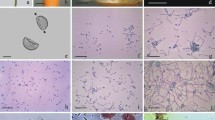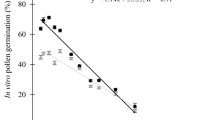Summary
The National Seed Storage Laboratory in Fort Collins, Colorado, is investigating pollen storage as a practical means for storing germplasm of clonally-held species. Careful regulation of pollen moisture content is necessary to safely store pollens and perform accurate in vitro germination tests. A series of dehydration and hydration curves were generated for Pinus ponderosa Dough. ex P. Laws., Picea pungens Engelm., and Carya illinoensis (Wangenh.) K. Koch pollens using five saturated salt solutions and water. Equilibrium moisture contents (EMCs) were also determined for Typha latifolia L., Phoenix dactylifera L., Corylus avellana L., and Zea mays L. Although rates of dehydration and hydration, and EMC varied with salt, pollen, and temperature, the pollens tested did survive the drying procedures and could successfully be stored in liquid nitrogen.
Similar content being viewed by others
Abbreviations
- NSSL -:
-
National Seed Storage Laboratory
- EMC -:
-
Equilibrium Moisture Content
- LN -:
-
Liquid Nitrogen
References
Berjak P., N.W.Pammenter & C.Vertucci, 1992. Homoiohydrous (recalcitrant) seeds: Developmental status, desiccation sensitivity and the state of water in axes of Landolphia kirkii Dyer. Planta 186: 249–261.
Brewbarker J.L. & B.H.Kwack, 1963. The essential role of calcium ion in pollen germination and pollen tube growth. Amer. J. Bot. 50: 859–865.
Copes D.L., 1985. Fertility of Douglas-fir pollen after one year of storage in liquid nitrogen. For. Sci. 31: 569–574.
Copes D.L., 1987. Long-term storage of Douglas-fir pollens. For. Sci. 33: 244–246.
Crowe J.H., F.A.Hoekstra & L.M.Crowe, 1989a. Membrane phase transitions are responsible for imbibitional damage in dry pollen. Proc. National Acad. Sci. 86: 520–523.
Crowe J.H., F.A.Hoekstra, L.M.Crowe, T.J.Anchordoguy & E.Drobnis, 1989b. Lipid phase transitions measured in intact cells with Fourier Transform infrared spectroscopy. Cryobiol. 26: 76–83.
Folch J., M.Lees & G.H. SloaneStanley, 1957. A simple method for the isolation and purification of total lipides from animal tissue. J. Biol. Chem. 226: 497–509.
Ganzer K.M. & L.Rebenfeld, 1987. Laboratory-scale continuously variable humidity control with saturated salt solutions. Amer. Lab. 19: 40–47.
Hecker R.J., P.C.Stanwood & C.A.Soulis, 1986. Storage of sugarbeet pollen. Euphytica 35: 777–783.
Hoekstra F.A., 1984. Imbibitional chilling injury in pollen. Plant Physiol. 74: 815–821.
Hoekstra F.A. & E.W.van derWal, 1988. Initial moisture content and temperature of imbibition determine extent of imbibitional injury in pollen. Plant Physiol. 133: 257–262.
Lanner R.M., 1962. Controlling the moisture content of conifer pollen. Silvae Genet. 11: 114–117.
Luza J.G. & V.S.Polito, 1987. Effects of desiccation and controlled rehydration on germination in vitro of pollen of walnut (Juglans spp.). Plant, Cell, Env. 10: 487–492.
Roberts E.H., 1973. Predicting the storage life of seeds. Seed Sci. Technol. 1: 499–514.
Sowa S., K.F.Connor & L.E.Towill, 1991. Temperature change in lipid and protein structure measured by Fourier Transform infrared spectrophotometry in intact pollen grains. Plant Sci. 78: 1–9.
Stanley R.G. & H.F.Linskens, 1974. Pollen: Biology, Biochemistry, Management. Springer-Verlag, New York.
Towill L.E., 1981. Liquid nitrogen preservation of pollen from tuber-bearing Solanum species. HortSci. 16: 177–179.
Towill L.E., 1985. Low temperature and freeze-/vacuum-drying preservation of pollen. In: K.K.Kartha (Ed.), Cryopreservation of Plant Cells and Organs, pp. 171–198. CRC Press, Inc., Boca Raton, Florida.
Vertucci C.W., 1989. Relationship between thermal transitions and freezing injury in pea and soybean seed. Plant Physiol. 90: 1121–1128.
Vertucci C.W. & E.E.Roos, 1990. Theoretical basis of protocols for seed storage. Plant Physiol. 94: 1019–1023.
Visser T., 1955. Germination and storage of pollen. Mededelingen van de Landbouwhogeschool, Wageningen Nederland 55: 1–68.
Winston P.W. & D.H.Bates, 1960. Saturated solutions for the control of humidity in biological research. Ecology 41: 232–237.
Yates I.E. & D.Sparks, 1989. Hydration and temperature influence in vitro germination of pecan pollen. J. Amer. Soc. Hort. Sci. 114: 599–605.
Yates I.E., D.Sparks, K.Connor & L.Towill, 1991. Reducing pollen moisture simplifies long-term storage of pecan pollen. J. Amer. Soc. Hort. Sci. 116(3): 430–434.
Young J.F., 1967. Humidity control in the laboratory using salt solutions—a review. J. Appl. Chem. 17: 241–245.
Author information
Authors and Affiliations
Rights and permissions
About this article
Cite this article
Connor, K.F., Towill, L.E. Pollen-handling protocol and hydration/dehydration characteristics of pollen for application to long-term storage. Euphytica 68, 77–84 (1993). https://doi.org/10.1007/BF00024157
Received:
Accepted:
Issue Date:
DOI: https://doi.org/10.1007/BF00024157




